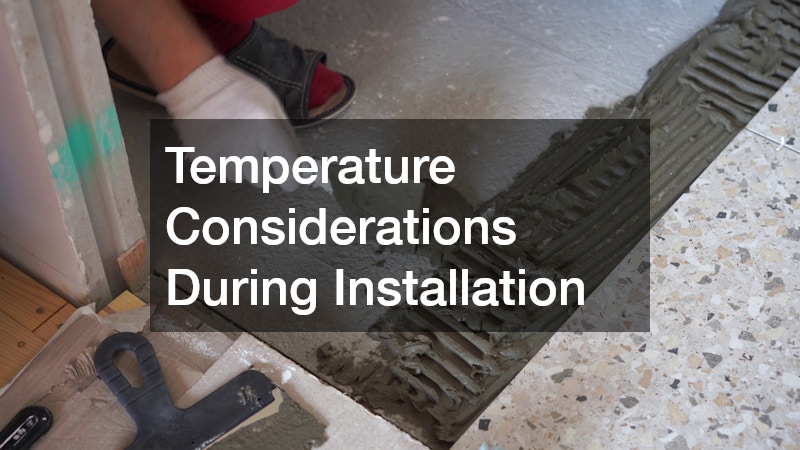In this article, we will explore the common pitfalls that many face during the floor installation process. Avoiding these mistakes can ensure a smooth installation process and a beautiful, lasting floor. Understanding the intricacies of flooring installation is crucial in preventing unnecessary expenses and laborious corrections.
How Improper Preparation Can Impact Flooring Installation
Importance of Subfloor Preparation
Ensuring your subfloor is clean, dry, and level is critical to preventing future flooring issues such as squeaks or uneven surfaces. An uneven subfloor can lead to visible imperfections and can significantly shorten the lifespan of your floor.
Therefore, investing time in thorough subfloor preparation can save considerable time, money, and effort in the long run.
Any debris or moisture left on the subfloor can become a breeding ground for mold, which poses both health risks and structural damage. Professional installers emphasize the importance of not only leveling but also ensuring the subfloor is well-sealed. A dry subfloor acts as the foundation for any flooring type and enhances its overall durability.
Skipping this preparation step often results in having to redo portions of the work, incurring further costs. A meticulously prepared subfloor contributes to a seamless flooring installation that will be visually satisfying and functionally sound. It is wise to consult experts or follow detailed guides specific to your flooring type to ensure the foundation is impeccable.
Mistakes to Avoid During Measurement
Accurate measurements are essential. Learn how overlooking this crucial step can lead to material shortfalls or excess costs. Miscalculations or assumptions during the measurement phase can lead to a range of problems, such as purchasing insufficient materials or having excessive waste.
Using the right tools and taking measurements multiple times is recommended to ensure precision. Relying solely on rough estimates can cause discrepancies that become costly when materials are ordered and cut. A well-measured floor saves resources and eliminates the frustration of running short or overstocking materials.
Material shortfall can postpone the project timeline, while excess materials incur unnecessary costs and storage issues. Professional installers advise double-checking dimensions and considering door frames, alcove spaces, and irregular room shapes. Being thorough in this phase lays the groundwork for smoother installation and financial savings.
Common Errors in Installing Different Types of Flooring
Mistakes Specific to Hardwood Installations
Hardwood floors are popular for their durability. Discover frequent errors like incorrect nail spacing and their long-term implications. Incorrect nail spacing can lead to loose boards and potential squeaking, which undermines the aesthetic and structural integrity of hardwood floors.
Moisture content measurement in hardwood is often overlooked, yet critical to ensure the wood remains stable over time. Failing to acclimate the wood to the site conditions may result in expansion or contraction post-installation. The adhesion and stability of hardwood floors are largely affected by how well the boards were secured during installation.
Sanding errors post-installation, such as uneven surfaces, can further depreciate the floor’s quality. Professional installers entail exact nail placement and consistent spacing, along with proper acclimatization before installation. Such precision prevents costly refinishing and repairs, ensuring the hardwood floor remains a prized element of the home.
Issues with Laminate or Vinyl Flooring Installations
These materials are less forgiving than they seem. Learn about common mistakes, such as improper acclimation and their effect on the installation. Failing to acclimate laminate or vinyl flooring can result in expansion bubbles or seams where the material may bow or buckle.
Unlike hardwood, these materials require specific climate-controlled conditions before installation to avoid post-installation issues. High moisture levels can cause the adhesive to break down in vinyl installations, leading to lifting and misalignment. Following the manufacturer’s acclimation instructions for these materials ensures that they remain flat and even after installation.
Another prevalent error is improper underlayment, which can negatively impact the feel and performance of laminate or vinyl flooring. The underlayment serves as a moisture barrier and adds insulation, resulting in better sound absorption and a more comfortable step. Ensuring compatibility of the underlayment with the flooring material prevents post-installation difficulties.
How Environmental Conditions Affect Flooring Installation
Impact of Moisture on Flooring
Moisture is a significant factor to consider. Understand how neglecting moisture levels can lead to warping or molding. High humidity or persistent moisture exposure can deteriorate even moisture-resistant flooring types over time.
Moisture testing before installation is essential to ensure the subfloor and the room’s general environment are in optimal condition. Moisture barriers are crucial in damp areas to uphold the flooring’s longevity and prevent warping. This is particularly true in basements or high-moisture areas like kitchens and bathrooms.
Addressing moisture issues preemptively compensates for the shortcomings associated with low-quality adhesives and limitations. Consistent monitoring and controlling of indoor humidity levels can stave off irreversible damage, enhancing both the durability and appearance of installed flooring. Professional advice and proper tools are invaluable in achieving moisture control for lasting installations.
Temperature Considerations During Installation
Temperature fluctuations can lead to flooring expansion or contraction. Learn steps to mitigate these effects. Warmer temperatures may cause certain flooring types to expand, whereas cooler temperatures can lead to contraction and potential stress fractures.
Manufacturers often provide ideal temperature guidelines that should be followed during installation to minimize expansion-related issues. Proper acclimatization during temperature extremes may involve adjusting HVAC settings to maintain consistency. This meticulous management of the installation environment assures that the flooring behaves predictably once installed.
By being aware of these top mistakes and taking the right precautions, you can ensure a successful flooring installation that enhances the beauty and longevity of your home. Proper planning and execution are key to avoiding costly errors. Foreshadowing potential problems and dealing with them proactively transforms the flooring installation process into a smooth, efficient project.

